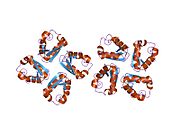KCNA3
| KCNA3 | |||
|---|---|---|---|
Gene ontology | |||
| Molecular function | |||
| Cellular component | |||
| Biological process | |||
| Sources:Amigo / QuickGO | |||
Ensembl | |||||||||
|---|---|---|---|---|---|---|---|---|---|
| UniProt | |||||||||
| RefSeq (mRNA) | |||||||||
| RefSeq (protein) | |||||||||
| Location (UCSC) | Chr 1: 110.67 – 110.67 Mb | Chr 3: 106.94 – 106.95 Mb | |||||||
| PubMed search | [3] | [4] | |||||||
| View/Edit Human | View/Edit Mouse |
Potassium voltage-gated channel, shaker-related subfamily, member 3, also known as KCNA3 or Kv1.3, is a protein that in humans is encoded by the KCNA3 gene.[5][6][7]
Potassium channels represent the most complex class of voltage-gated ion channels from both functional and structural standpoints. Their diverse functions include regulating neurotransmitter release, heart rate, insulin secretion, neuronal excitability, epithelial electrolyte transport, smooth muscle contraction, and cell volume. Four sequence-related potassium channel genes – shaker, shaw, shab, and shal – have been identified in Drosophila, and each has been shown to have human homolog(s).
This gene encodes a member of the potassium channel, voltage-gated,
Function
KCNA3 encodes the voltage-gated Kv1.3 channel, which is expressed in T and B lymphocytes.[6][8][9][10][11][12][13] All human T cells express roughly 300 Kv1.3 channels per cell along with 10-20 calcium-activated KCa3.1 channels.[14][15] Upon activation, naive and central memory T cells increase expression of the KCa3.1 channel to approximately 500 channels per cell, while effector-memory T cells increase expression of the Kv1.3 channel.[14][15] Among human B cells, naive and early memory B cells express small numbers of Kv1.3 and KCa3.1 channels when they are quiescent, and augment KCa3.1 expression after activation.[16] In contrast, class-switched memory B cells express high numbers of Kv1.3 channels per cell (about 1500/cell) and this number increases after activation.[16]
Kv1.3 is physically coupled through a series of adaptor proteins to the T-cell receptor signaling complex and it traffics to the
Blockade of Kv1.3 channels in effector-memory T cells suppresses calcium signaling,
Kv1.3 has been reported to be expressed in the
Clinical significance
Autoimmune
In patients with
At therapeutic concentrations, the blockers did not cause any clinically evident toxicity in rodents,
Metabolic
Kv1.3 is also considered a therapeutic target for the treatment of obesity,
Neurodegeneration
Kv1.3 channels have been found to be highly expressed by activated and plaque-associated microglia in human Alzheimer's disease (AD) post-mortem brains [37] as well as in mouse models of AD pathology.[38] Patch-clamp recordings and flow cytometric studies performed on acutely isolated mouse microglia have confirmed upregulation of Kv1.3 channels with disease progression in mouse AD models.[38][39] The Kv1.3 channel gene has also been found to be a regulator of pro-inflammatory microglial responses.[40] Selective blockade of Kv1.3 channels by the small molecule Pap1 as well as a peptide sea anemone toxin-based peptide ShK-223 have been found to limit amyloid beta plaque burden in mouse AD models, potentially via augmented clearance by microglia.[38][39]
Blockers
Kv1.3 is blocked
See also
References
- ^ a b c GRCh38: Ensembl release 89: ENSG00000177272 – Ensembl, May 2017
- ^ a b c GRCm38: Ensembl release 89: ENSMUSG00000047959 – Ensembl, May 2017
- ^ "Human PubMed Reference:". National Center for Biotechnology Information, U.S. National Library of Medicine.
- ^ "Mouse PubMed Reference:". National Center for Biotechnology Information, U.S. National Library of Medicine.
- ^ a b "Entrez Gene: KCNA3 potassium voltage-gated channel, shaker-related subfamily, member 3".
- ^ PMID 2251283.
- S2CID 219195192.
- S2CID 4340921.
- S2CID 30410512.
- PMID 6088661.
- PMID 2305265.
- S2CID 45657700.
- PMID 1547020.
- ^ PMID 15120495.
- ^ PMID 12782673.
- ^ PMID 15240664.
- PMID 14745040.
- ^ PMID 17088564.
- ^ PMID 18835197.
- ^ PMID 15632141.
- ^ PMID 18818304.
- PMID 8702786.
- PMID 12807917.
- PMID 18940791.
- PMID 11602626.
- PMID 16043714.
- ^ PMID 11717451.
- PMID 15665253.
- PMID 17984097.
- PMID 17273162.
- PMID 14579513.
- PMID 18542083.
- PMID 12588802.
- PMID 14981264.
- ^ S2CID 37002854.
- PMID 16317062.
- PMID 25362031.
- ^ PMID 29272333.
- ^ PMID 29784049.
- PMID 28651603.
- S2CID 8598481.
- S2CID 21383597.
- PMID 18471844.
- S2CID 18538305.
- S2CID 12308227.
- PMID 8645244.
- S2CID 9180663.
- PMID 9830012.
- PMID 10419508.
- PMID 18480054.
- PMID 19122005.
- PMID 9063464.
- S2CID 6931552.
- PMID 25976092.
- PMID 10607427.
- PMID 12643934.
- PMID 8967992.
- PMID 9802971.
- PMID 19104661.
- PMID 9116272.
- PMID 16200586.
- S2CID 43528153.
- S2CID 36255192.
- PMID 7829710.
- PMID 17570206.
External links
- KCNA1+protein,+human at the U.S. National Library of Medicine Medical Subject Headings (MeSH)
- Kv1.1+Potassium+Channel at the U.S. National Library of Medicine Medical Subject Headings (MeSH)
This article incorporates text from the United States National Library of Medicine, which is in the public domain.



